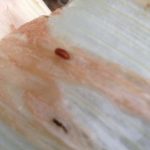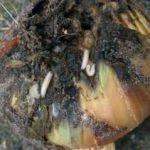How to Grow Shallots – A Guide to Growing Shallots
 Shallots
Shallots
Shallots have a reputation as a gourmet vegetable, prized by chefs for their mild flavour although there is nearly as much variation between varieties as there is with onions. In some ways shallots are easier to grow than onions and have a big advantage in that they store better than onions, possibly due to their being smaller. 12 months is usual for storing shallots and we’ve had them keep in good condition for 18 months.
It is possible to grow shallots from seed but they’re normally bought as sets. Each set then produces offsets and by harvest time has formed a ring of anything from 4 to 9 full size shallots.
Preparing the Soil for Shallots
Like onions, shallots like a firm soil with a fine tilth. If you’ve rotovated or dug over, ‘heel and toe’ tread the soil firm prior to planting. They will tolerate acidic soil to about pH 5.5 but prefer neutral soils, pH 7.0 so lime if needed to reduce acidity.
Prepare the soil by raking in 60 grams per square metre of general purpose fertiliser like fish, blood & bone or Growmore a week before planting out.
Cultivating Shallots
Traditionally they are planted, like garlic, on the shortest day to harvest on the longest but in reality they should be planted in February but can go in as late as the end of March and still produce a respectable crop to harvest in June and July
Traditional spacing was to go 10 to15cm apart in rows 22cm apart but my preference is to plant 20cm apart each way which allows plenty of room for growth.
Like set grown onions, shallots like a firm soil but just pushing the set into firm earth can damage the root plate, effectively killing the set. Take the corner of a hand hoe or trowel and scrape a little hole as deep as the set. Place the set in the hole and push the loose soil around, just leaving the tip of the set visible.
Once planted, there’s little to do apart from weed and it is important that the weeds are kept down as shallots are easily swamped out by them. Do be careful if hoeing as the shallow-rooted shallot is easily damaged with a slip of the hoe. I prefer to hand hoe and weed the shallot bed.
Shallot Problems
Although shallots are subject to many of the same problems as onions, they rarely bolt and seem to be less susceptible if not immune to rusts and rot although white rot will affect them as onions.
The biggest problem I’ve had with shallots has been the birds pulling out the sets the day after planting so cover with netting, fleece or cloche until they’re established.
Harvesting and Storing Shallots
Shallots are harvested as a clump with the individual bulbs in a ring. |Whilst there is no need to split them apart until you come to use them, they are easier to dry off when split.
Lift directly, gently using a fork to lever up if need be but usually when ready to harvest they will be loose in the soil. As with onions, dry them off and then place into a string bag or on slatted shelves and keep in a cool dark place with some airflow.
You can string shallots in a similar way to onions but as the shallot is smaller and there are more of them, you may prefer to just tie in bunches and hang up, removing a bunch at a time for use in the kitchen.
Shallots store very well and 12 months isn’t unusual. We’ve successfully stored them for 18 months. They are really useful at the end of the season as they fill the gap when the stored onions run out before the new crop arrives.
Shallot Varieties
There are basically 3 types of shallot; yellows, reds and the French Jersey types which are more elongated in shape. Unlike the other types some of the French varieties don’t store as well so check your supplier’s catalogue or ask them if it’s not clear.
The French Jermor which has won the prestigious RHS Award of Garden Merit is easy to grow and well flavoured. Red Sun produces a good flavoured and sized bulb with Golden Gourmet being a good yellow variety.
Seed Saving
As long as the crop is disease free, reserve the best examples storing as above until plant those out. By only planting the best you’ll gradually improve your strain selecting for your soil and climate conditions. I’ve come across a chap who had been using his own seed shallots for 20 years and they performed exceptionally well for him.





